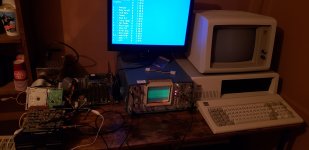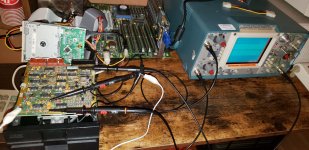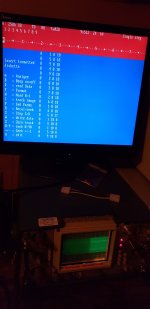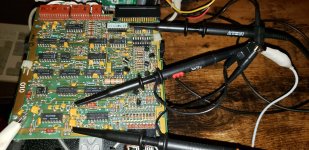Tincanalley
Experienced Member
I am on my last repair of a batch of drives. All other cleaning and repairs went perfectly and I now have 5 drives. However, the 6th one is being a pain. I cleaned it up, silicone oiled all rails and spindle bearing. The carriage moves back as smoothly as the stepper motor will let it (those steps make for a bumpy travel). It moves as easily as all my other drives, so I'm assuming the stepper doesn't need lube. However, the carriage does some odd things and I don't know if it's the controller board or the motor, or????
I used IMD and at first things seem to be out of alignment, but I accidentally put it on double step. When I changed that, I was able to step through all the tracks, zero it, step the tracks again, over and over. The speed as also correct. That's when I decided to format it with the program. It formatted quickly and very quiet. I then tested it again and it read all the tracks and changed perfectly from 0-39. That's when I decided to exit to DOS and copy some file to it. That's when things went wrong. It copy a copy files copied and then couldn't find the sector. I tried to read it, and nope. I then used IMD again, but this time it was only showing track 39. I tried to return to track 0, but it still showed 39. I looked at the carriage and when I tried to zero it, it didn't move. When I tried to go to track 40, it just moved back and forth about 1/8th an inch and stopped. So I took it apart again and when I moved it by hand, it was fine. There was no sign of it being stuck or hard to move.
So that's where I am. Not sure if it is with electronics or mechanical. Also, of all the drives I have, why does this one make a knock when it move back to track 0? By hand or stepper, it knocks when it hits the set screw on the back of the case. Is there something missing? A rubber piece? It's odd and very annoying seeing as how everything else on the drive is almost silent
I used IMD and at first things seem to be out of alignment, but I accidentally put it on double step. When I changed that, I was able to step through all the tracks, zero it, step the tracks again, over and over. The speed as also correct. That's when I decided to format it with the program. It formatted quickly and very quiet. I then tested it again and it read all the tracks and changed perfectly from 0-39. That's when I decided to exit to DOS and copy some file to it. That's when things went wrong. It copy a copy files copied and then couldn't find the sector. I tried to read it, and nope. I then used IMD again, but this time it was only showing track 39. I tried to return to track 0, but it still showed 39. I looked at the carriage and when I tried to zero it, it didn't move. When I tried to go to track 40, it just moved back and forth about 1/8th an inch and stopped. So I took it apart again and when I moved it by hand, it was fine. There was no sign of it being stuck or hard to move.
So that's where I am. Not sure if it is with electronics or mechanical. Also, of all the drives I have, why does this one make a knock when it move back to track 0? By hand or stepper, it knocks when it hits the set screw on the back of the case. Is there something missing? A rubber piece? It's odd and very annoying seeing as how everything else on the drive is almost silent




